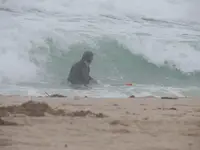cyperpc
Jr. Member
- Joined
- Nov 18, 2012
- Messages
- 96
- Reaction score
- 124
- Golden Thread
- 0
- Location
- Bucks County, PA
- Detector(s) used
- Minelab Equinox 800;Fisher CZ-21; White Classic IDX Pro; White Classic SL
I put my Fisher CZ-21 on a military surplus web belt with a harness to hold up the belt. Have a pair of driver's shoes and a 6″ Monster Aluminum/Stainless Steel Water Scoop. Put my sun glasses and hat on and off to the surf I went. I was in the water chest high and small waves coming in that sometime would put water up my noise. I got into the rhythm of letting the water take the coil in and out. I found it was best to keep my back to the waves. The coral was along the shore line so had stay in the water between 1 to 4 feet.
I was in the water about 20 min and I hit a target!! Oops I can not see the coil. Tried to hold still but the waves where bounding me around; one foot up, one foot back. Tried to run the scoop along the rod to the coil but could not hold still. After about hour trying to time the waves and moving around I gave up and went back to the shore. Boy did I get a good workout.
Now I need to find out what that target was. It could be a coin, ring or junk and I can't just let it sit there now that I know something is there.
Maybe I should get driver's weight? MD in the surf is harder then you think!
I was in the water about 20 min and I hit a target!! Oops I can not see the coil. Tried to hold still but the waves where bounding me around; one foot up, one foot back. Tried to run the scoop along the rod to the coil but could not hold still. After about hour trying to time the waves and moving around I gave up and went back to the shore. Boy did I get a good workout.
Now I need to find out what that target was. It could be a coin, ring or junk and I can't just let it sit there now that I know something is there.
Maybe I should get driver's weight? MD in the surf is harder then you think!
Amazon Forum Fav 👍
Upvote
0




 …
…


